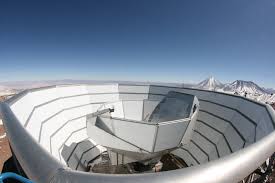Research
21cm Radio Instrumentation to measure Large Scale Structure and Dark Energy
An enduring question in cosmology is the nature of Dark Energy, a mysterious component that makes up ~72% of the energy density of the Universe and is causing the expansion of the Universe to accelerate. To better understand this baffling substance, we will require measurements of the expansion rate further in the past (at higher redshift). One interesting new pathway for these measurements are to use the 21cm signature of neutral hydrogen in galaxies to make measurements of the distribution of galaxies over more than 60% of the sky in a new redshift range. This will tell us about the expansion rate of the Universe at a critical era when Dark Energy began impacting the expansion rate.
 The Canadian Hydrogen Intensity Mapping Experiment ( CHIME) is a set of 4 cylindrical dishes, each 100m long x 20m wide, located in British Columbia, Canada. It operates at 400-800MHz, to provide measurements of structure at redshifts z=0.8-2.5. The sky signal is focused onto a feed line at the focus of the cylinders, and detected by 1024 dishes connected to the largest correlator in radio astronomy. Our work focuses on measuring the ‘beam’ of the CHIME telescope: it’s response on the sky. This must be measured extremely precisely to be able to make high-fidelity maps of the sky to extract the cosmological signal. We are pursuing multiple routes for this measurement: flying radio sources on quadcopter drones, and using an old radio technique, holography, for this measurement.
The Canadian Hydrogen Intensity Mapping Experiment ( CHIME) is a set of 4 cylindrical dishes, each 100m long x 20m wide, located in British Columbia, Canada. It operates at 400-800MHz, to provide measurements of structure at redshifts z=0.8-2.5. The sky signal is focused onto a feed line at the focus of the cylinders, and detected by 1024 dishes connected to the largest correlator in radio astronomy. Our work focuses on measuring the ‘beam’ of the CHIME telescope: it’s response on the sky. This must be measured extremely precisely to be able to make high-fidelity maps of the sky to extract the cosmological signal. We are pursuing multiple routes for this measurement: flying radio sources on quadcopter drones, and using an old radio technique, holography, for this measurement.
 The Hydrogen Intensity Mapping and Real-time Analysis eXperiment (HIRAX) will be a set of 128 dishes, each 6m in diameter, located in the Karoo Desert in South Africa. Its science will also include a radio transient component to study Fast Radio Bursts (FRBs) and pulsars. We plan to extend HIRAX to a set of 1024 dishes in the future. We are working on calibration and characterization of the HIRAX design: noise measurements of the radio analog instrumentation using two RF chambers designed and built here at Yale, and beam measurements of the HIRAX dishes with drones.
The Hydrogen Intensity Mapping and Real-time Analysis eXperiment (HIRAX) will be a set of 128 dishes, each 6m in diameter, located in the Karoo Desert in South Africa. Its science will also include a radio transient component to study Fast Radio Bursts (FRBs) and pulsars. We plan to extend HIRAX to a set of 1024 dishes in the future. We are working on calibration and characterization of the HIRAX design: noise measurements of the radio analog instrumentation using two RF chambers designed and built here at Yale, and beam measurements of the HIRAX dishes with drones.
Early Universe Cosmology: The Cosmic Microwave Background
The Cosmic Microwave Background (CMB) is the relic light from the Universe when it was ~380,000 years old. Measurements of the CMB have been a workhorse in precision cosmology, constraining parameters like the geometry of the Universe and its constituents (dark matter, baryonic matter, neutrinos, dark energy) and provide the high-precision measurements required for additional constraints from Large Scale Structure (like those mentioned above).
 The Atacama Cosmology Telescope (ACT) is a 6m dish located in the Atacama Desert in Northern Chile. The current receiver is AdvACT, a polarization sensitive receiver which will take data at 5 different frequency bands across at least 3 years. We use it to make high resolution measurements of the CMB: the power spectrum to high angular scale, lensing in both temperature and polarization, and measurements of the thermal and kinetic Sunyaev-Zeldovich effect in clusters. We are currently taking data through 2021.
The Atacama Cosmology Telescope (ACT) is a 6m dish located in the Atacama Desert in Northern Chile. The current receiver is AdvACT, a polarization sensitive receiver which will take data at 5 different frequency bands across at least 3 years. We use it to make high resolution measurements of the CMB: the power spectrum to high angular scale, lensing in both temperature and polarization, and measurements of the thermal and kinetic Sunyaev-Zeldovich effect in clusters. We are currently taking data through 2021.
Simons Observatory will be a new experiment in the Atacama Desert and is a joint endeavour between the ACT and POLARBEAR collaborations. We will build and deploy four new telescopes in Chile near ACT and Polarbear. The Newburgh group works on data acquisition, software development, and subsystem hardware development.